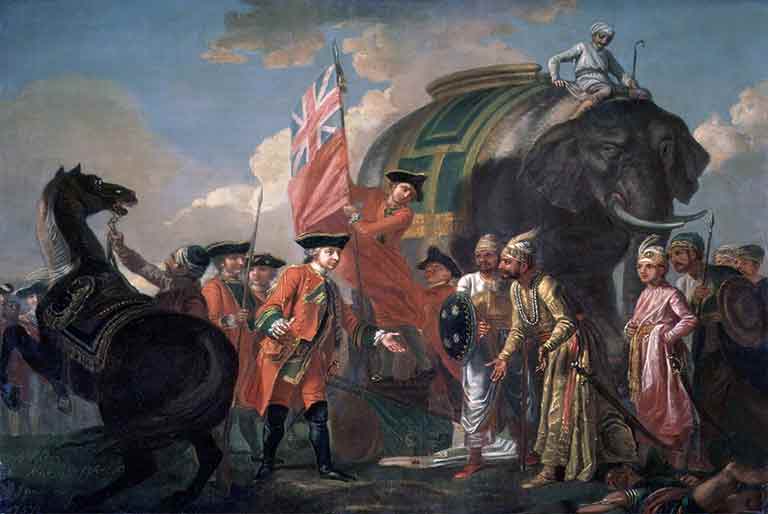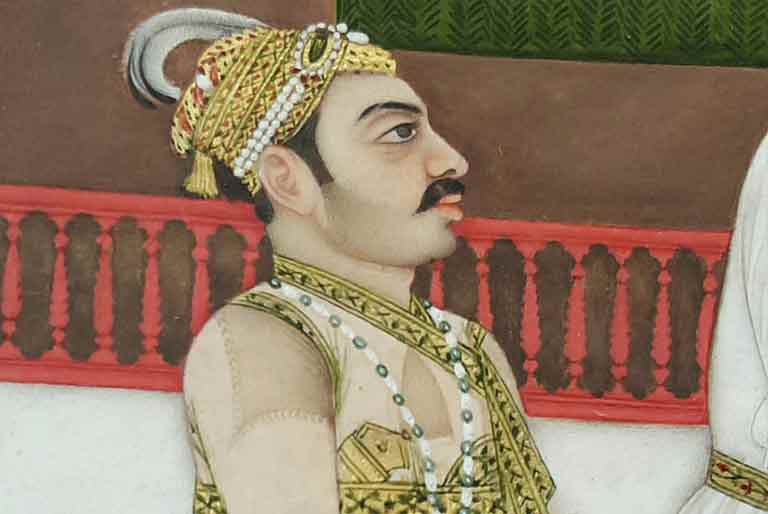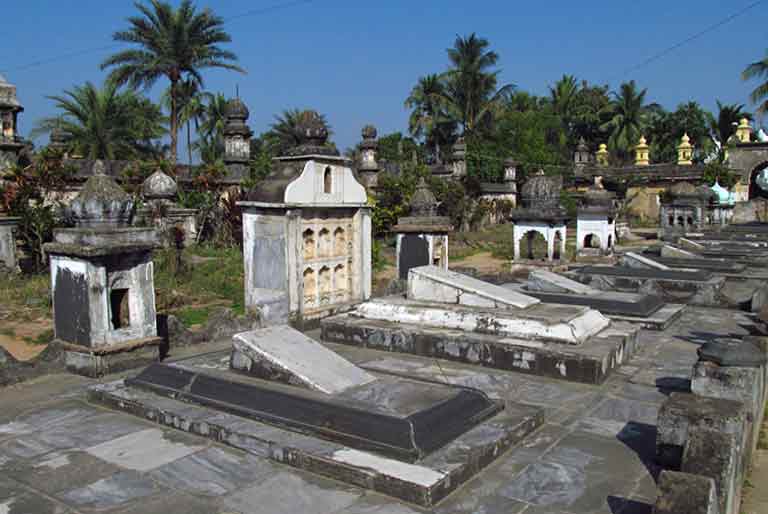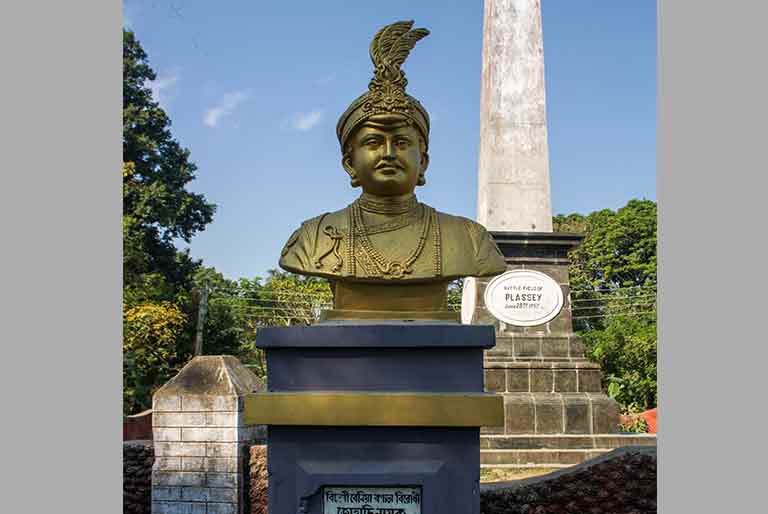Back To Blogs / Blogs / Jan 2021
Battlefield of Plassey - The Lower Ganges
The Battlefield of Plassey – A priceless piece of history in the Lower Ganges
The quaint village of Palashi along the Hooghly River in the Lower Ganges River witnessed an event on 23rd June 1757 that brought it out of oblivion into the limelight. The event was an encounter of the Nawab Siraj-ud-Daulah’s army with the East India Company’s army, headed by Robert Clive. Although it was an unimpressive military encounter, it was a very momentous one that marked the start of nearly two centuries of British Rule in India. That event is known across the world today as the Battle of Plassey.
The Battle of Plassey (Palashi Judda) was a battle that took place on the 23rd day of June, in the year 1757, along the banks of the Bhagirathi River, and approximately 150 km north of Calcutta. Palashi is a small village near Murshidabad – the erstwhile capital of the Nawab of Bengal in India. The village Palashi is close to the battlefield and was named after an extravagant red flowering tree – the Palashir – or 'Flame of the forest'. A phonetically-accurate Romanising of this Bengali name would rightly be Battle of Palashi, but it is now conventionally known as 'Plassey'.
The village Palashi
Palashi has a total population of almost 20,000. According to the 2011 Census of India, over 66% of the population is literate. The village is connected to Kolkata by both bus and railway routes, with quite a few express trains stopping in Plassey railway station.
The events that lead to the Battle of Plassey
In India, the British East India Company represented Britain. It was a venture that had been permitted by way of a royal charter to take part in the East Indian spice trade and included the right to form its own army. The French East India Company too had the same permit. To gain an advantage in India, the rival companies fought each other in the Carnatic wars. They continued to maintain strong trading posts in India and tried to influence local rulers.
In 1755, Siraj-ud-Daulah became the first Nawab of Bengal. He adopted a pro-French Policy and overran trading posts held by the British, including those in Calcutta.
The British sent over Lieutenant Colonel Robert Clive, Commander-in-Chief of British India, from Madras to regain Calcutta. This is where the plotting to overthrow the Nawab began.
Mir Jafar was a discontented follower of Nawab Siraj-ud-Daulah. The British knew about this and secretly bribed him into helping them overthrow the Nawab. Several Bengali generals too were bribed by the British. Mir Jafar wrote to Clive to confirm that in the event of a battle against Nawab Siraj- ud-Daulah, he would join the English against the Nawab. It was at this point that Clive decided to march toward Plassey, where Siraj-ud-Daulah and his army were camped.
On the morning of 22nd June 1757, the East Indian Company’s army crossed over to the east bank of the Bhagirathi River using a flotilla of boats which carried all their required supplies. The crossing took the entire day and brought Robert Clive and his army a mere 15 miles of Plassey. The army continued marching again at sunset. The area witnessed early monsoons that year, and by this time, it was raining heavily, with the river overflowing its banks and forcing soldiers to march in water that in some places reached up to their waists.

Battle of Plassey

Nawab Siraj-ud-Daulah
The Battle of Plassey – 23rd June 1757
The British reached their destination at midday on 23rd June 1757. Their destination was just beyond the village of Palashi. They occupied an adjoining mango grove that was around 800 yards long and 300 yards wide, had several rows of mango trees, and diagonally angled to the River. They placed videttes around the grove. In the distance, they could hear music coming from the camp of Nawab Siraj-Ud-Daulah.
The area that the British camped in was enclosed by a ditch and a mud wall. Just north of the mango grove, by the riverbank, was a hunting lodge that was owned by the Nawab. Clive took residence at the lodge. A mile away was the Nawab’s entrenchments.
There was a small hillock that was covered by jungles just 300 yards east of a redoubt that was mounted by cannon. There was also a small reservoir approximately 800 meters toward the British position and a larger tank about 100 yards south of the smaller tank. Both the tanks were surrounded by large mounds of earth.
Early in the morning of June 23rd, the Nawab’s army emerged from camp and advanced toward the grove. The Nawab’s army included 30,000 infantry soldiers armed with swords, pikes, and rockets, 20,000 cavalry that were armed with spears and swords, 10 war elephants, 300 bits of artillery, and 40 cannons. The French too had sent artillerymen to strengthen the Nawab’s army with more than 50 guns.
The French were positioned at the larger tank, just a mile off the mango grove. Behind the French were the Nawab and his strong army. 45,000 soldiers of the Nawab’s army formed an arc from the small hill to 800 yards east of the southern angle of the grove. By the look of things, they were ready to surround Robert Clive’s army that was composed of 750 European infantries, 100 artillerymen who were assisted by 50 sailors, and 2100 sepoys.
The winning of the battle
At first, it seemed that the British had no chance of winning the battle. But several factors led to the British defeating the Indian and French forces.
Nawab’s army had a major disadvantage. The gunners were not well-trained. The locally- manufactured guns were of inferior quality and produced a very slow rate of fire – taking almost 15 minutes to fire a single round as opposed to the British army that fired several rounds in a matter of a minute.
The Nawab’s generals were bribed by the British, which made them privy to the Nawab’s war tactics beforehand. Mir Jafar was promised the throne if he helped the British win the battle against the Nawab. Mir Jafar provided the British with vital information before and during the war that helped them win the battle.
The evening of the battle witnessed a heavy thunderstorm. The British troops that knew about battles in monsoon-laden countries knew what needed to be done. They immediately protected their gun powder by building tarpaulins and covering all their ammunition. The Nawab’s army did not have tarpaulins and could not protect their ammunition. As a result, their gun powder was damaged and rendered useless by the rain. Their fire fell away.
The betrayal of the Nawab’s generals, the loss of the Nawab’s army’s gun power due to heavy rain, and the underhandedness of the British eventually led to the end of the 11-hour long battle that was eventually won by Robert Clive’s army.
The Battle of Plassey was one of the most major events during the time and led to the arrival and the establishment of British rule in Bengal, the colonisation of the Indian subcontinent, and the British rule in India over the next 200 years. The Battle was not just about a battle between local authorities – a lot of the rivalry was also over the available markets.
The British dug trenches and built mounds of mud through which they fired precisely at the Nawab’s army. The Nawab’s canon, on the other hand, simply fired above the heads of the British troops and destroyed the groves.
After the defeat of the Nawab at the Battle of Plassey, the British East India Company gained extremely large amounts of wealth from the Bengal treasury. With these new riches, the Company was able to strengthen its military might.

Jafarganj Cemetery at Murshidabad

The Monument of Battle of Plassey
Palashi and The Battlefield of Plassey today
It is no wonder that the battlefield of Plassey is still visited fondly – not just by the British and by the Indians themselves, but by people of all nationalities. The short battle on the open green that later came to be known as the Battlefield of Plassey is remembered for several reasons. It was here that a mighty army fell to the ground. It was here that an army that was outnumbered won. It was the consequences of this battle that reinforced the British occupancy in India.
The village of Palashi obtained historical significance when the battle of Plassey was fought on 23rd June 1757, when Nawab Siraj-Ud-Daulah was famously defeated by Robert Clive in a battle that was fought on an open green between Kolkata and Murshidabad. The area was known as Palashi, but anglicised by the British to 'Plassey'.
Today, a monument known as the Palashi Monument stands tall in the village. The monument is protected by the Archaeological Survey of India. The battleground where the historical battle was fought is marked with several shrines, memorials and obelisks to honour the lives of the fallen generals and soldiers of Siraj-ud-Daulah’s army.
There is a set of three obelisks that mark homage to the area where the chief of artillery (Bakshi Mir Madan), the Commander of Musketeers (Bahadur Ali Khan), and the Captain of Artillery (Nauwe Singh Hazari) were killed during the battle. A plaque indicates that they were leaders of the Nawab Siraj-Ud-Daulah, and fell at the spot at 2 p.m. on the 23rd of June 1757.
There is a golden-coloured statue of Siraj-Ud-Daulah that lies close to the Palashi Monument, in a small clearing surrounded by fields and mango orchards.
The tombs of Siraj-Ud-Daulah and Mir Jafar, as well as their wives and several generals, lie around the town of Murshidabad.
Mausoleums have been built around the tombs of Nawab Siraj-Ud-Daula and Azimunessa begum, as well as around several other soldiers who had died during the war. These can be found at Khoshbagh (meaning the garden of happiness) and Jafarganj cemetery.
When cruising along the Lower Ganges River, on day 3 time permitting, you will get to visit the battlefield of Plassey.